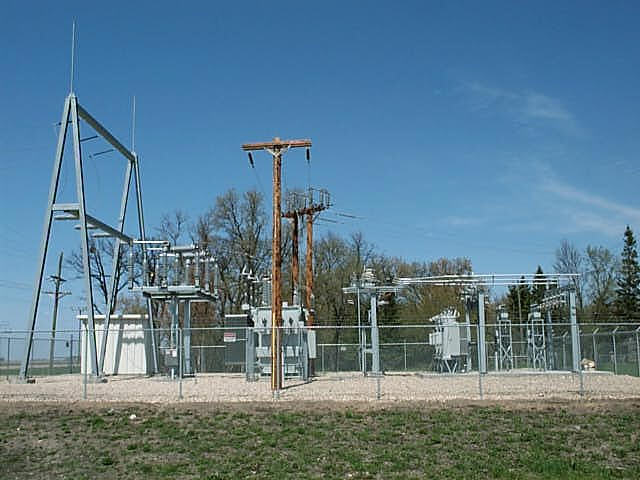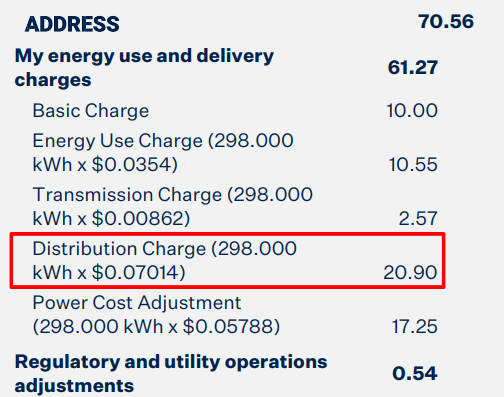More Nickle-and-Diming? PGE Wants $72.3 Million for Grid Investments
Posted on October 21, 2025 by Charlotte Shuff
Tags, Energy

This year, Portland General Electric (PGE) is passing on asking for big adjustments to customers’ bills. While this is good news after multiple years of big rate increase requests, CUB is on the lookout for utilities nickel-and-diming customers. One case we’re looking closely at is a request from PGE to pass distribution system costs onto customers starting next spring.
PGE is requesting a 2.8% increase from household customers this year, about $4.50 a month for an average customer. This amount would be higher for winter bills as energy use naturally spikes. This is one of many smaller amounts PGE has asked the Oregon Public Utility Commission to put into customers’ bills this year. And the scope of the request raises a lot of questions.
Want to go even deeper into this issue? Check out docket UE 459 at the Oregon Public Utility Commission!
What is the Distribution System?
This case is related to distribution investments: equipment like the meters on our homes, the wooden poles we see on our streets, and substations close to our homes and businesses. Added up, PGE is asking for $72.3 million, mainly from residential customers.
Read More: Oregon’s Power Grid 101 (CUB Blog)
Electricity Delivered in Our Neighborhoods
The electricity grid comprises three main parts that work together to generate and transport electricity from a power plant to your home or office. Those parts are electricity generation, transmission, and distribution.
Generation is where electricity is created, like a power plant or a wind farm. Transmission is how that electricity is moved from faraway places (sometimes other states!) into the places we live and work at very high voltages. Distribution starts at substations where the electricity is moved to a lower voltage and delivered through neighborhoods and into homes and businesses!
What’s generally included in distribution system costs:
- Substations
- Utility poles
- Overhead cables
- Transformers
- Meters

Substation in a neighborhood
By Wtshymanski at English Wikipedia - Transferred from en.wikipedia to Commons by Drilnoth using CommonsHelper., Public Domain, https://commons.wikimedia.org/w/index.php?curid=6405246
Modern Grids Require Modern Solutions: New Costs Go Beyond Distribution
PGE has been very focused on “grid modernization” over the past few years. These new technologies have changed how we manage the electricity on our grid, often for the better. Now, we have smart technology like meters, electric vehicle charging, thermostats, and more that allow utilities to lower customer usage remotely when there are big demands for energy.
For customers who opt into these programs, on a really hot or really cold day when energy demand is very high, utilities can remotely adjust thermostats by a few degrees to help manage overall demand. When customers have rooftop solar, they are sending electricity back into the grid. These are very important tools for saving energy — and costs — for all customers.
But these technologies also change how we think about distribution. In the past, distribution systems only went one way: delivering electricity to customers. Now, the investments we are making are benefiting the whole system and are not as clearly defined as just “distribution” investments. For example, when a residential customer’s solar panel, EV, and/or battery sends electricity back to the grid, this is less about distributing electricity. It is the generation of new electricity, not dissimilar from a large power plant or a large wind farm, just on a smaller scale.
The problem is that the customers who benefit the most from opting into programs with smart technologies are typically well-off homeowners, leaving lower-income customers and renters behind in the benefits.
Household Customers Take on Distribution Costs
Generally speaking, residential customers are given most of the costs of the distribution system relative to other customer groups, like commercial or industrial. And this has made sense for a long time.
When you think about your neighborhood, most of the buildings around you are likely places where people live. Each of those homes is one customer of a utility. And we’re all the ones who need the most equipment to get electricity from that local system, such as a meter and connection cable to the nearby overhead power line. Businesses, schools, and other buildings need this equipment, too, but there are fewer of them on our blocks.
So it follows that the group of customers who have the most need pays for most of the infrastructure costs! But with the advent of two-way technologies, like with grid modernization, it’s less clear that residential customers should continue paying as big a share as we have been for distribution costs.
Distribution Costs are a Big Chunk of Your Power Bill
When you look at your PGE bill, you can see that a big portion is going directly to distribution costs.

But because the costs of a few power lines and transformers here and there are relatively small, these costs get a lot less attention. If we’re concerned about making energy bills more affordable, distribution costs are a good place to focus to make an impact for Oregon families. It’s such a big portion of our monthly bills!
But PGE doesn’t want us to focus on these costs. In fact, the way the utility is asking to add to your bills is making it incredibly difficult for us to even write this blog to tell you about what PGE is proposing.
$72.3 million… But You Can’t Know What For
Here’s what we can say for certain:
- PGE is asking for $72.3 million from customers
- Household customers are likely to pay the majority of that amount
- Before filing this case, PGE agreed to keep it to just distribution costs
But almost everything beyond those statements is hidden behind red tape and confidentiality agreements. To even submit formal testimony in the legal case investigating PGE’s request, you would need to lawyer up and sign confidentiality agreements. One of the reasons CUB exists in the first place is to be the customer advocates with those lawyers. But our legal team and analysts can’t be the only ones in the know!
We need more transparency in this process so customers like you know what you’re paying for.
Are All of These Costs Even for Distribution Investments?
CUB can’t say. Not because our analysts don’t have enough information. But because our legal team told us we couldn’t include that information in this blog, due to PGE labeling much of this case as confidential.
And that’s a problem.
What we can say is that we have some serious questions about whether PGE is expanding the scope of this request to include costs that are outside the scope of what they agreed to. The public can see the big buckets of spending like “grid modernization,” “transportation electrification integration,” and “virtual power plant.” And within those, there are categories such as “compliance” and “action plan,” but actual projects and their costs are not public information.
If Oregonians are footing the bill, we deserve more transparency.
Is PGE Asking to Charge Customers for Necessary Investments?
Once again. CUB can’t say. This time, not because of confidentiality. But because regulators haven’t yet finished reviewing PGE’s plan for what customers need from the distribution system. This is being decided in a separate case (UM 2362) before the Oregon Public Utility Commission, which hasn’t even ended.
With grid modernization, we need to make sure that the new technology we are investing in is actually necessary, not just “gold plating” the system with high-tech solutions that are more expensive. We also need to make sure that these costs are spread fairly, so residential customers aren’t footing too much of the bill for investments that benefit everyone. Big businesses that use a lot of electricity, like data centers, are often the ones benefiting the most from these investments without paying their fair share.
In fact, the Commission won’t even decide on if PGE’s plan for its distribution system is adequate until the end of October. This case is also riddled with red tape and confidential information. PGE filed its ask to pass these $72.3 million costs onto customers in July.
Regulators must ensure that we’re only paying for what is fair and necessary.
We Need Your Help to Push Our Regulators to Hold PGE Accountable
Regulators need to know that customers won’t stand for decisions being made in the shadows. We’re asking you to join CUB in calling for more transparency in what is going into our power bills. We’re asking you to speak out on reigning in unnecessary and sneaky costs. And we’re asking you to push our regulators to hold PGE accountable for smart, affordable, and necessary investments.
We only have a few weeks left until this case becomes even more secretive. The next phase of the case will be done almost entirely through attorneys, with even less on the public record. While public comments will still be open through early next year, now is the time to make your voice heard! Submit your comments by October 31 for the biggest impact.




10/21/25 | 1 Comment | More Nickle-and-Diming? PGE Wants $72.3 Million for Grid Investments